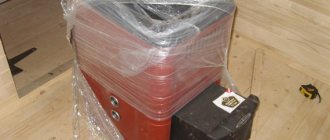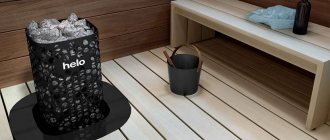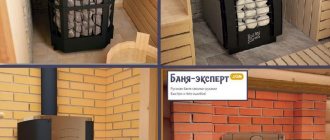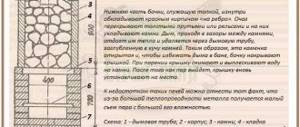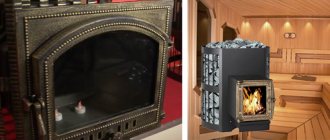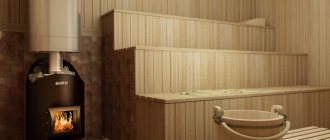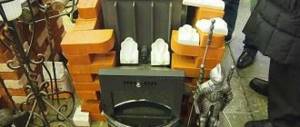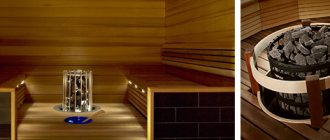| • Yaroslav's 1A • Bathhouse. 1B Peter 1C | • Around Vilnius • In the Cathedral 2 | • Bath Day 3A • End of Bath Day 3B | • Ramunas has 4 • Trakai. Angels |
June 9, 2013 Yaroslav took us to introduce us to the city of Trakai.
Along the way he showed us the field of Angels.
Trakai is the historical center of Lithuania. On this day there was a holiday in Trakai. A brass band was playing on the street. Yaroslav told us that many years ago Karaites settled in Trakai. Today it is a whole block, like a village. He treated us to karaite pies. We walked around the city, around the fair, and someone bought some sweets or some interesting trifle.
Then he took us to Ramunas, a famous and ardent fan of the bathhouse. Lithuanian. For this rage he was banned from the RusBani forum.
Occupation: computer scientist, massage therapist, bathhouse attendant, stove maker.
In Trakai.
2. In Trakai on an excursion near the Karaite quarter. Behind us is the famous castle.
3. The brass band in Trakai plays like the good old days.
| Bathhouse Pyramidas , built by Ramunas. Very original design. |
There is a swan in the lake. From the steam room along the grass to the lake is a pleasure (water 20C). The water in the font is cold - about 11C. When I measured the temperature and humidity in this steam room, my device failed. At first it showed 100%, then an error.
“The influence of Pyramidas,” Ramunas noted phlegmatically.
| Subsequently, it turned out that it was necessary to occasionally check and tighten the contacts. |
I nevertheless carried out measurements and they showed that the microclimate at the level of a person lying on a shelf is similar to that in Yaroslav’s bathhouse: 42-44C and 95-100% humidity.
We (3-4 people) steamed after the St. Petersburgers (3-4 people - about 6 visits), in the afternoon. Those. oven m.b. “asked” to be flooded.
I even WASHED before going on the road, which happens very rarely during such meetings of bathhouse lovers. Usually there is neither time nor opportunity for this.
And the remaining procedures were completed: Warming up, Sweating, Massage and Cold (lake and plunge pool). I didn’t want to leave the steam room.
| Comment: Long-term tests of various baths and surveys of bathhouse lovers lead to a recommendation from the “Union of Bathhouse and Stove Specialists” - 60°C and 60% (or about that). |
I personally like any mode, as long as the bathhouse warms you to sweat (from 45C) and doesn’t burn (up to 70C) - it doesn’t dry out your nasopharynx and eyes.
Further, I would say this.
Overheating of a person, which steamers strive for (and this is what happens in the steam room), is stress for a person, as physiologists say. Moderate and short-term stress stimulates the body, severe stress causes shock, long-term stress tires, and both of the latter lead to death.
| Therefore, it would be necessary to be able to create a mode with stimulating heating. |
It would be nice to have the body’s heating not weak, not strong, not long, but deliciously moderate.
7. Guests from St. Petersburg, Moscow and Karelia with the host, Ramunas. Ramunas “keeps its shape” - for a long time only raw food.
8. Swan in the lake. Inna with Ramunas. Ramunas with a dog.
| 9. Interesting design of the Ramunas furnace with a main pipe (left) and a top pipe. The heater is closed with a horizontal lid. Comment: The stones are heated in the fire, but they are not located as is often done - above the firebox, but on the side of the firebox. As a result, the stones are heated only by the passing combustion products, and the radiant heat from the coals does not reach them (IMHO). In addition, stagnation zones appear in the corners of the heater, which are not heated by combustion products. |
| The photo shows that the soot on the stones and the lid did not burn off. Guild stovemakers try to remove soot using a gas burner. Sometimes stones are placed in the chimney to heat it. Here, in essence, the stones are placed in a hog. |
10. View of the folded stove. Stones in the heater. Here is a sensible message about the couple from 5_6: https://www.forumhouse.ru/threads/155679/page-7#post-3898534
| Ramunas (left), at a time when he was not a raw foodist. |
11. Movement of gases in a furnace with a main pipe (not shown). Read more on the Builders forum
Many thanks to the owner of such a soulful bathhouse! Good luck to you, Ramunas! And see you later!
12. Panorama from Ramunas’s house. On the left is Pyramidas. On the right is the greenhouse.
From Peter Semyonov : I would like to especially say that I personally have absolutely nothing against the log house. A log structure is sound, reliable, and thorough. Some houses and bathhouses are simply amazing! But it's expensive! Now imagine how many bathhouse lovers there are in the territory of the former USSR? Millions. And everyone, I’m just sure that everyone, openly or secretly dreamed or dreams of their own cozy bathhouse. And how many such lovers bury their dreams for material reasons! Or it becomes a curiosity. A few years ago, one of the dacha neighbors proudly boasted that they were already building a bathhouse for him for only 1.5 thousand dollars. Now I can’t look at this chicken coop from the stockroom without tears. And every season he walks around it and caulks, caulks, caulks... At one time, thanks to the Internet, I came to the decision to build a frame bathhouse. My turnkey construction costs were about $5 thousand. Moreover, most of this amount went to pay employees. And although these were my friends and comrades, I paid them for their work at the prevailing rates, because they had families and children. In general, as Lenya Golubkov said, I’m not a freeloader... Several years of operating my bathhouse, the experience of other forum members (Igor Vasiliev, Andrey Zakharovich, etc.), soaring in bathhouses on wheels, also of a frame type, all this confirms my conviction: - log house is not a necessary and obligatory condition for a proper bath. Mandatory conditions include the correct stove and solid wood paneling in the steam room. Ramunas's bathhouse is a clear confirmation of this. According to him, construction costs amounted to about 2 thousand euros. And I saw that this is an absolutely real figure. Because everything in this bathhouse is made with your own hands. Its very form is extremely economical. The roof and walls are one whole. There are no abashas and cedars, LODE bricks and Finnish fittings. But this bathhouse has the main thing - the correct conditions in the steam room. And you can argue and disagree with the author’s solutions for the screed, for the plinth; perhaps these options are not ideal. But we must take into account that the bathhouse was built in an area with certain climatic conditions, on specific soil with a certain level of groundwater. Materials were selected based on their availability on the farm or purchase at reasonable prices. But these decisions are not dogma and are easily adjusted to any other specific conditions.
The sauna stove deserves special mention . There is very detailed information about it on various forums, for example on the stove makers forum https://www.stroiteli. read.php?t=3002. Since the construction of the first copy, the stove has undergone a number of changes and improvements. With the hands of Ramunas, a whole series of stoves was built in different baths. There are orders, there is a photo of the masonry of each row of one of the stoves, there is a video of the processes of kindling, combustion, and the work of the secondary. One of the forum members from the builders forum took part in the construction of the furnace from scratch to the first firing as a helper. That is, the author generously shares his work and this cannot but arouse great respect for him. The oven is very economical. This is achieved by the design of the firebox. combined with a cap in combination with a lowering channel. It is possible to supply secondary air through the holes in the double combustion door, passing between two cast iron plates, the air is additionally heated. Tertiary air can be supplied to the lower part of the lowering channel and the gases are burned under the stone backfill. A clean, almost invisible release of gases from the pipe indicates complete combustion of the fuel. And this is a consequence of the fact that the stove was designed with a deep understanding of combustion processes; very precise proportions of the dimensions of the grate, the volume of the firebox, the cross-section and length of the channels were found. The furnace components are arranged sequentially horizontally: a firebox, a heater, and another hood for additional heat removal from exhaust gases. This arrangement ensures the highest maintainability of the furnace. Any of the nodes can be iterated without affecting other nodes. And this is very important for a sauna stove. And at the same time, the design is very simple and easy to replicate by amateurs. There is no need for higher education. A middle consideration is needed. I must admit that in all the mentioned parameters, Ramunas’s stove is superior to the “Motivated stoves”, which many forum users, including the author of this writing, built in various modifications. I guess I'll finish here. But I want to appeal to all members of the forum, and first of all to Ramunas. Friends! We have gathered here because we are like-minded people, we all love the bathhouse. Let's treat each other with respect, be tolerant and respectful of the opinions of our opponents. Rudeness, insults, and labeling will not lead to anything good. But if the topic “Ramunas Sauna Stove” appeared on the forum, it would be interesting and useful to a huge number of sauna lovers.
Size selection
When choosing a drawing, you need to determine the overall dimensions of the brick sauna stove. They are selected based on the volume of the heated steam room and according to personal preferences. But in the most common options, for ease of laying, the base area is chosen to be either 3.5 by 4 bricks, or 4 by 5 bricks. The height is adjusted according to ease of use and in accordance with the distance to the ceilings. As a rule, stoves are made 168 or 210 cm. These dimensions take into account only the heating unit itself, without the chimney structure.
Materials for sauna stove
Now you can move on to choosing a material for the stove, taking into account its reliability, resistance to rotting, and safety when heating.
Stove mixture
The main material used to lay a sauna stove is ordinary clay and sand. Do not forget that when wet, the volume of clay increases, and when it dries, on the contrary, it decreases. Therefore, if masonry is carried out in conditions of high humidity or at low temperatures, the clay swells. For certain jobs, clay is not used, for example, when creating a pipe above the roof or when constructing a foundation. There are several types of clay. Firstly, a fire-resistant or refractory type, used at temperatures above six hundred degrees (fireclay mortar is used only for fireboxes made of fireclay bricks of grades ША-8 ША-5). Secondly, refractory clay, used in the temperature range from five hundred to one thousand five hundred degrees (can be used in a firebox for refractory bricks). Thirdly, low-melting clay, suitable only in cases where the temperature does not exceed five hundred degrees (external walls, channels and pipes to the roof).
Furnace center. Materials
When mixing clay mortar, a number of requirements must be met; not only the appearance, but also the reliability of the masonry will depend on them. The ideal combination of clay and sand is one part clay to two or three parts sand, depending on the fat content of the binder. All components must be sifted before mixing. Next, fill the mixture with plain water, keeping in mind that one part of the mixture will require four parts of water. Leave for several hours to swell and bloom. At the final stage, the solution must be carefully placed; it is best to use a special construction mixer for this. This is if you prepare the mixture yourself the old fashioned way. Nowadays, a large number of baking mixtures are presented on the markets. You can purchase them at almost any furnace center.
Choosing a brick
Today on the building materials market you can find a huge selection of bricks of various shapes and colors. During the production process, bricks are fired, so they are divided into three types. Firstly, red brick, it is well fired and has smooth edges. Secondly, pink brick is different in that it is not fired enough. Thirdly, dark brown brick. This is a burnt brick. It is used when laying a sauna stove to create a foundation.
General provisions
Remember that the position of the stove is determined not by your desire, but by safety requirements. It is advisable to use only good material in your work. In no case should you use sand-lime or slotted bricks, as they do not heat up well. Having prepared the required amount of brick, you need to start mixing a solution of clay and sand.
Before laying, the brick is sprayed with water, then the mortar is applied with a trowel and laid in the desired place. Excess clay mixture is carefully removed. During work, it is necessary to regularly check the verticality and horizontality of the masonry using a building level and a plumb line. A mandatory requirement when laying a sauna stove is to check the internal walls for chips and excess mortar. Note that the internal seams are not rubbed with clay, due to the fact that when heated it will crack and crumble, thereby clogging the chimney.
All furnace elements, such as doors, valves, taps, are installed immediately after the completion of the masonry process.
After finishing the oven, you need to give it a couple of days to dry.
Stones for sauna stove
Every person perceives the bathhouse as a place to cleanse the body and relax. Having such a building in the country, or visiting a sauna in the city, people can provide themselves with relaxation and relief from stress accumulated during the week.
To create a welcoming atmosphere in the bathhouse, it is equipped with a stove, high-quality finishing and stones designed to maintain the required temperature inside the room.
Characteristics of stones for a sauna heater stove
What characteristics of stones should you pay attention to when choosing
To select the right natural species, you need to take into account their following features:
1) Heating and duration of heat transfer.
Rocks with large sizes (monolithic type) and weight have these characteristics. The stone is not susceptible to damage as a result of temperature changes.
2) Thermal resistance, which consists in the rock’s tolerance to severe loads (heat and cooling).
When choosing minerals for a bath, this indicator deserves special attention, since by choosing the wrong rocks, owners are faced with rapid deterioration.
The rock itself can be tested directly in the store by heating and flash cooling. If there are no cracks or other defects, the stones can be safely purchased.
3) Stones of certain sizes may be suitable for a specific type of stove.
If you have electric furnaces, you need to use rock with a diameter of up to 75 millimeters. Large pieces can be purchased for wood-burning units (up to 155 millimeters in diameter).
4) The environmental friendliness of materials is of great importance, since many of them have a high radiation content. Specially treated products should be selected.
Products with high quality immediately catch the eye, due to the smooth and even surface, as well as the absence of inclusions.
What types of breeds are best for good steam?
If bathhouse owners want to save money, pebbles (sea or river) are the best option.
When choosing materials, it is best to focus on oval and flattened stones, as they will be able to fit into a dense layer and create optimal conditions for steam circulation.
You should not buy pebbles if they contain brick-red inclusions (iron oxide), as they will quickly deteriorate.
Cast iron stones are also a popular budget option. Artificial products have different shapes and optimal prices. At the same time, manufacturers guarantee high quality for a long period.
Among the more expensive breeds in demand are:
• Jadeite (a semi-precious mineral with a green tint: it costs a lot, but it allows you to get light steam in the bath and has a long service life).
• Soap chloride (gray stones that perfectly absorb and release heat).
• Gibbro-diabase (a volcanic stone that has similar features to marble, but should not be exposed to too much temperature or exposure to oil or flavorings).
• Raspberry quartzite (ideal for placement in a sauna).
In the end, it is worth noting that when choosing a breed, you need to focus on your own preferences, as well as the type of stove placed in the bathhouse. Only in this case will your vacation bring pleasure.

